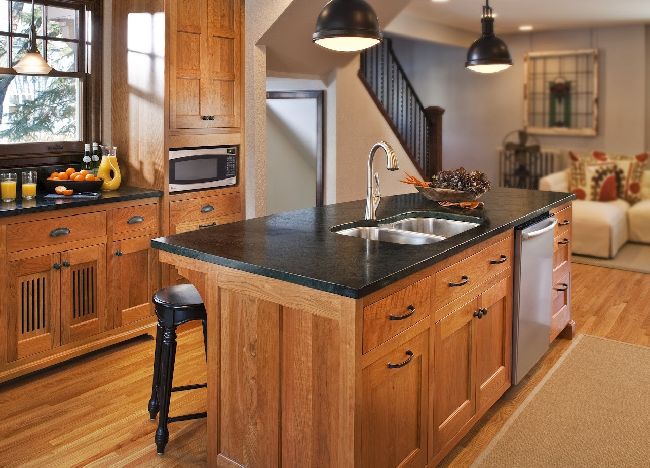
For those who crave perfection, laying Soapstone countertop themselves is a great idea. The beauty of the stone enhances manifold when it is laid with your own creativity at work. It also leaves space for customization to suit your kitchen’s decor and design needs. The work of masonry is tardy, but the thrill of having accomplished a difficult work is blissful to say the least.
Here we have laid out a step by step guide just for you to have that perfect soapstone. Soapstone requires little maintenance and can work for many years. To do it yourself requires a large amount of time and money, but it is worth having your own self made soapstone. Bite in the goodness and enjoy!
Difficulty: This is not a task like your average household chore. Challenging to put it straightforward.
Time Required: Depends. If you are working, it may take you several weekends.
Resources required: soapstone countertop, luan plywood, adhesive caulking, epoxy, painter’s tape, nylon string, plastic foam, fast-drying mineral oil, level, square, spring clamps, clamps, tape measure, circular saw with diamond blade, random-orbit sander, mask, safety glasses, glue gun, straightedge, file, 80-grit sandpaper, sandpaper, router, diamond bit, edge sander with vacuum attachment.
Estimate Cost: $ 10,000 – $ 15,000
Instructions
Step 1. Measure and Build the Templates
Soapstone has exceptional density and is a malleable, which means it can be moulded into sheets. It is a elegant, countertop material. Measurement is very important in masonry, so you must first measure it precisely to cut and install countertops, backsplashes, or islands. Eliminate irregularities in the back wall and measure each part of the countertop. Take a 1-1/4’’ overhang at front edge before cutting any stone. Make sure the measurements are correct.
Using a nylon string and level, make sure the cabinets are square and plumb. Build a template for each piece of the stone that needs to be cut. This is helpful for pieces that have unusual shapes. Use 3/8’’ or ½’’ luan plywood for the template. Tightly fit, nail and glue the template to the cabinet bases. Lay the template on the stone and clamp it. Mark the boundary with a pen to see when cutting.
Step 2: Cut and Sand
Carve the stone with a circular saw and a dry cutting diamond table. As using the saw, set up a straight edge. With a steady hand, cut along the marked lines. Sand it with a 36-grit sandpaper after cutting. Do remember to wear a mask while cutting. The overhang should be 1-1/4’’. Dry sand it and make sure it fits exactly.
Step 3: Measure and Cut the Island Counter
Next, measure the island. Template is not needed for the stones because they are rectangular. The island will be made from three separate pieces of soapstone. For eating areas add an overhang of 12 inches and 8 inches on two different sides. The other sides maintain 1-1/4’’ overhang. The island measures 70 inches from side to side and 37 inches from front to back. The measurements are to be transferred from the island to the stone.
Because of its sheer size, the island counter is made by joining three different pieces together. Each piece measures 37’’ x 23-1/3’’. Cut each part for the island. The edges have to be treated in a different way as the pieces will be joined together. Smoothen them by using a router with a diamond bit along the seam. You should work the router alongside the edges in a back and forth motion while applying a steady and even pressure. Use a linear edge to avoid any wrong cuts. This will ensure a tight seam that will vanish when the pieces will be joined together.
Step 4: Set the Island Pieces
Keep the three pieces for drying and check the seams. The island should appear seamless. Check the veins and look how they move across the seam. By positioning the stone differently, the seam can vanish. Once you are done with the positioning of the stones, you can set them in place with the right overhang measurements and clamp them.
Glue the soapstone into place. You must glue with a fast drying epoxy and with the cabinet with an adhesive caulk. Tape the edges of the seam with painter’s tape to diminish cleaning of epoxy. Start with an end piece. Place the soapstone on the block of foam and unclamp the stone. Place a small bead of adhesive caulk in a smooth line. Set the stone into earlier position. It should be exactly in place. Shift the center stone onto the foam blocks. After applying caulk to the cabinets as you have done before, apply quick drying epoxy to the seams of the stone. Place the middle stone into earlier position and squeeze the epoxy together against the first stone. Repeat for last stone. Compress the pieces together. Let the adhesive and epoxy dry.
Step 5: Sand the Countertops
After the epoxy and adhesive is dry, sand off excess epoxy with a belt sand and smooth the whole stone. Wear a mask and collect the dust by using a vacuum. Apply requisite pressure to smooth the surface. The belt sander should be used with 36-grit sandpaper. For rounding the corners, use a tape roll as template and trace the round edge to make a soft round corner. Repeat on every corner of the island. Use the belt sander to sand down the corner for corner mark. You can do it by twisting your body and rocking back and forth by rubbing yourself against it.
Now it’s the turn of the edges of the island. Take a fine cut file and 80-grit sand paper. File the edge firmly and then sand it gently. Repeat throughout the island.
Step 6: Return to the Stove Counter
Now the trendy kitchen counter. The stove will have two rectangular pieces on either side, and no template is needed for this. Measure the dimensions and transfer them directly for carving to the stone. Do check for the 1-1/4’’ overhang. Cut the stones with a circular saw and sand them with belt sander. Set the pieces for drying and check that they fit correctly and glue them with adhesive caulking. Make templates for pieces around the sink. Transfer the cut pieces to soapstones, cut, mark, sand and set them in proper place by using the adhesive caulk and epoxy. Tape the seams to diminish cleaning. Push against the pieces to firmly set them in requisite places. You might want to add a window ledge made of soapstone above sink. Measure, cut, sand as you did before. Hold it in place using shims. You should glue to it after installing backsplash behind the sink.
Step 7: Install the Faucet
To install a faucet into the soapstone, first measure carefully for the hole or holes (if you want to install more than one) that need to be cut. You may have various installation procedures, which depends on the brand and the model of the faucet. You should follow the manufacturer’s manual that accompanies the faucet. With an orbit sander, sand the seams of the faucet. This will prevent a circular impression on the stone. You should hook the sander to a vacuum as sanding helps to hide the seams. After finalising on the location for the faucet, fit it dry and make sure it fits tightly. It should function perfectly. Take a regular hole saw and drill a circular saw. Install and connect to plumbing.
Step 8: File and Sand the Edges
Carefully file the edges of the countertop as you have done with the island. A 80 grit sandpaper and a fine cut file is fine to file and sand the edges. If you think more sanding is required, then use a finer sandpaper and sand the edges.
Step 9: Install the Backsplash
For adding a backsplash against the wall around the counter’s perimeter, you should check that the height matches the moulding. For this project the masons took a large piece and combined it with a piece directly on the rear of sink which reaches the window ledge. Carefully measure and cut pieces for backsplash. Set them for drying and check that they fit.
For the seams, use painters tape and smoothen the edges with epoxy. Apply adhesive caulk to the bottom edge and to the wall. With a wet rag, smoothen the caulking line.
Step 10: Apply the Finishing Oils
Now after gluing the pieces of soapstones and sanding them, you are now ready to use your kitchen. The last step is to treat the surface with the mineral oil. After pouring on the countertops, spread it on a rag. After covering the exposed areas, they will turn from light grey to black. Take a dry cloth and wipe off the excess oil. Oil protects the surface and prevents after spills stains.
Now, finally, wipe off the sweat from your forehead and enjoy your kitchen.
Frequently asked questions
Q.1 Why should I use fast-dry epoxy?
Ans. Fast dry epoxy helps in quickly joining the pieces together. It is a very strong glue which will hold the pieces together in place.
Q.2 Should I consult anyone in case of any confusion?
Ans. Of course. If you are not being able to tweak around a bit, then you should always take the help of a professional rather than spoiling the piece.
Q.3 Why should I wear a mask?
Ans. When sawing or cutting, many dust particles and many marble particles will come out so it’s imperative that you wear a mask so that the particles don’t go into the lung.
Q.4 I am not comfortable sawing, what to do?
Ans. It is better to get yourself acquainted with the various techniques of masonry before starting out on this project. It is better to know how to do various things like sawing, cutting and sanding than to damage the marble or wood.
Q.5 The faucet does not work, why?
Ans. The faucet may not work as it may not have been connected properly to the plumbing. Check the manufacturer’s manual for correctly installing the faucet. Check the supply from the plumbing, and if still not working, then do call a plumber.
Q.6 Why is it necessary to keep overhang?
Ans. Overhang is for the clean look in the soapstone and also that if you make any mistake, then the overhang can be used to make new measurements.
Q.7 How to select the marble for soapstone?
Ans. The material should be selected based on what you are going to do on it. Cut things on it if that is what you are gonna do. See its response. Slide things on it, throw liquids on it. It should maintain its sheen even after many hours of liquid on it. See if it’s easy to clean afterwards.
Quick tips
1. You should have all the tools ready.
2. Take care that all the tools are in good condition, and are sharp for performing the tasks.
3. Wear a mask for protection.
4. Use good quality woods and marble.
5. Epoxy glue should be applied properly.
6. Oils should be applied carefully as it will give finishing to the system.
7. If you are attempting something like this for the first time, always keep a reserve amount of wood and marble.
8. Keep a first aid box with you.
9. All measurements should be made carefully and all cutting should be done with a steady hand.
Things to watch out for
1. The mask should be in a proper working condition as it will save you from harmful chemicals.
2. Carefully saw taking care of your hands and other body parts.
3. Oils should be carefully applied.
4. Keep extra reserves of materials in case you damage anything.
5. The wood and marble should be sturdy.
6. Carefully select the marble as mentioned before.
7. Apply the painters tape on the seams for proper results.




